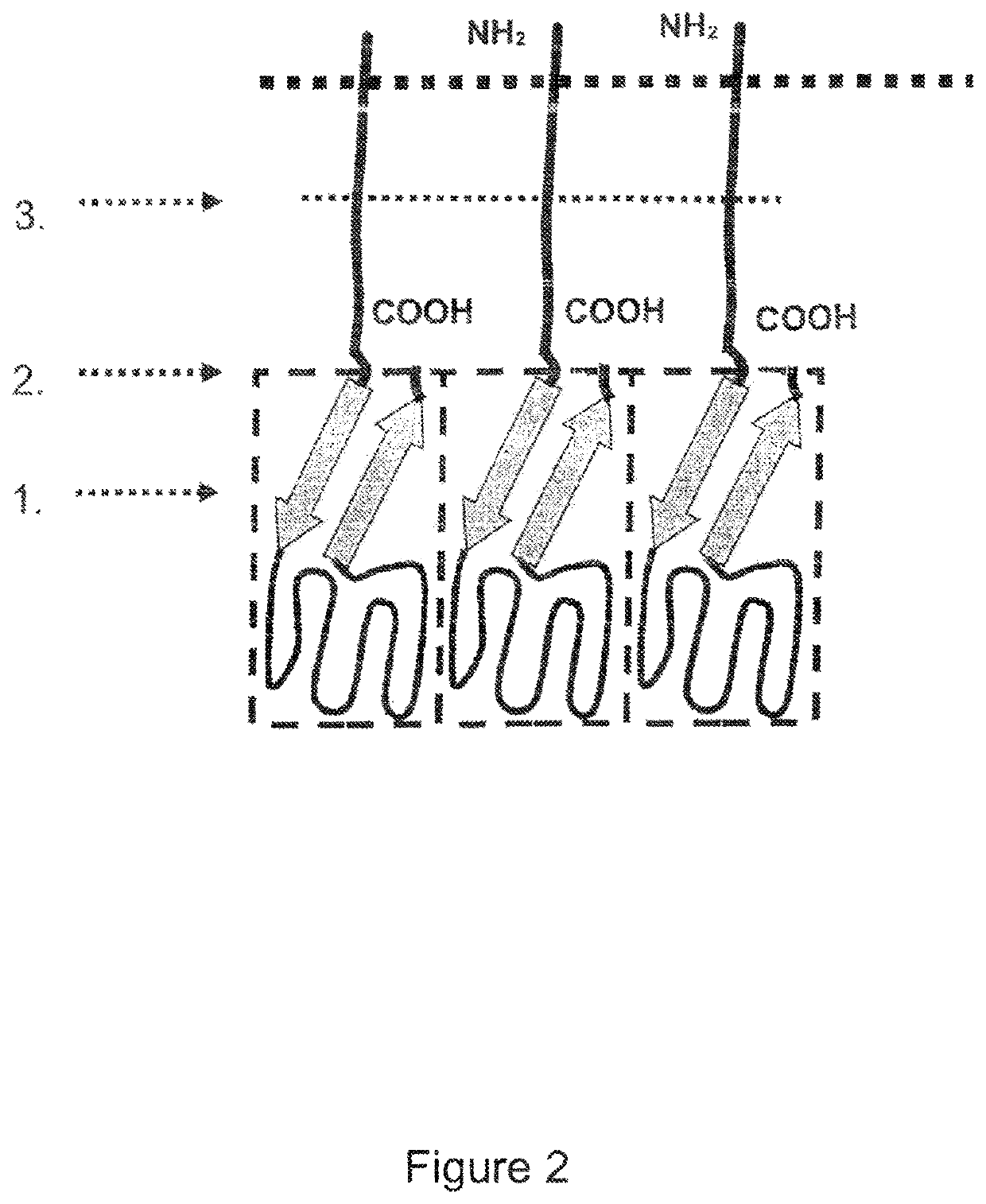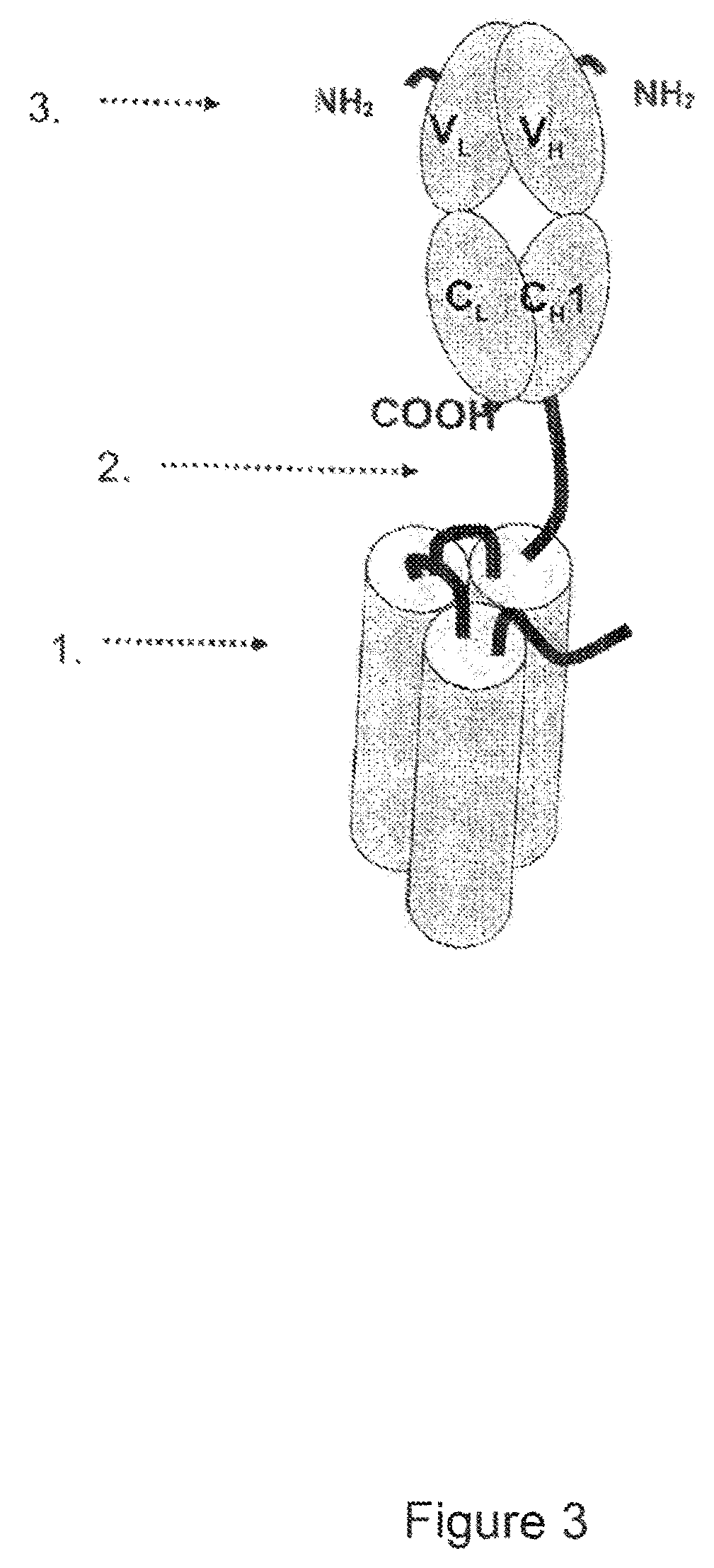Single-chain light receptor agonist proteins
a single-chain light receptor and agonist technology, applied in the field of specific light receptor agonist proteins, can solve the problems of difficult preparation of trimeric complexes of tnf superfamily cytokines from recombinant monomeric units, large molecular weight of trimerization domains, and inefficient trimerization, so as to achieve short in vivo half-life and low proteolytic degradation
- Summary
- Abstract
- Description
- Claims
- Application Information
AI Technical Summary
Benefits of technology
Problems solved by technology
Method used
Image
Examples
example 1
Manufacture of a LIGHT Receptor Agonist Protein
[0121]A) Amino Acids Met1-Gly20[0122]Ig-Kappa-signal peptide, assumed signal peptidase cleavage site after amino acid Gly 20.[0123]B) Amino Acids Glu21-Val170[0124]First soluble cytokine domain of the human LIGHT (LIGHT, amino acid 91-240 of SEQ ID NO: 1).[0125]C) Amino Acids Gly171-Ser 178[0126]First peptide linker element of SEQ ID NO: 2.[0127]D) Amino Acids Pro179-Val325[0128]Second soluble cytokine domain of the human LIGHT (LIGHT, amino acid 94-240 of SEQ ID NO: 1).[0129]E) Amino Acids Gly326-Ser329.[0130]Second peptide linker element of SEQ ID NO: 11.[0131]F) Amino Acids Pro330-Val476[0132]Third soluble cytokine domain of the human LIGHT ligand (LIGHT, amino acid 94-240 of SEQ ID NO: 1).[0133]G) Amino Acids Gly477-Cys497[0134]Hinge-linker element of SEQ ID NO: 16.[0135]H) Amino Acids Pro498-Lys715[0136]Antibody Fc fragment domain of SEQ ID NO: 13.
[0137]The above LIGHT receptor agonist protein is shown in SEQ ID NO: 25
[0138]The ind...
example 2
Expression and Purification
2.1 Cloning, Expression and Purification of Fusion Polypeptides
[0143]The aforementioned fusion proteins are expressed recombinantly in two different eukaryotic host cells employing the methods described below:
Method for Small Scale Expression of Light Receptor Agonist Fusion Proteins:
[0144]For initial analysis of aforementioned LIGHT receptor agonist fusion proteins, Hek293 cells grown in DMEM+GlutaMAX (GibCo) supplemented with 10% FBS, 100 units / ml Penicillin and 100 [mu]g / ml Streptomycin are transiently transfected with a plasmid containing an expression cassette for a fusion polypeptide and an appropriate selection marker, e.g. a functional expression cassette comprising a blasticidine, puromycin or hygromycin resistance gene. In those cases, where a plurality of polypeptide chains is necessary to achieve the final product, the expression cassettes will be either combined on one plasmid or positioned on different plasmids during the transfection. Cell c...
example 3
Determination of Temperature Stability
[0154]The stability of PROTEIN A (scLIGHT-RBD-Fc) upon elevated temperatures was assessed. Therefore, this protein was exposed for 10 min in an incubator for the indicated temperatures and then cooled on ice. The binding activity towards its receptor HVEM was then assessed employing the following ELISA assay:
[0155]Plates were coated with HVEM-Fc. PROTEIN A (heat treated and non-treated control) was added to the plate and then detected via its Strep-Tag employing StrepTactin-HRP. Binding activity of the non-treated control was set as 100%. Values below 100% indicate a loss in binding activity towards the receptor.
[0156]The results from the temperature stability evaluation for PROTEIN A at concentration of 75 ng / ml are summarized in the following
[0157]
PROTEIN A (scLIGHT-RBD-Fc)Relative Binding to Receptor [%]Control10050° C.8760° C.9170° C.9580° C.91
[0158]Surprisingly, PROTEIN A (scLIGHT-RBD-Fc) is very stable upon exposure to elevated temperature...
PUM
| Property | Measurement | Unit |
|---|---|---|
| volume | aaaaa | aaaaa |
| concentration | aaaaa | aaaaa |
| concentration | aaaaa | aaaaa |
Abstract
Description
Claims
Application Information
 Login to View More
Login to View More - R&D
- Intellectual Property
- Life Sciences
- Materials
- Tech Scout
- Unparalleled Data Quality
- Higher Quality Content
- 60% Fewer Hallucinations
Browse by: Latest US Patents, China's latest patents, Technical Efficacy Thesaurus, Application Domain, Technology Topic, Popular Technical Reports.
© 2025 PatSnap. All rights reserved.Legal|Privacy policy|Modern Slavery Act Transparency Statement|Sitemap|About US| Contact US: help@patsnap.com



